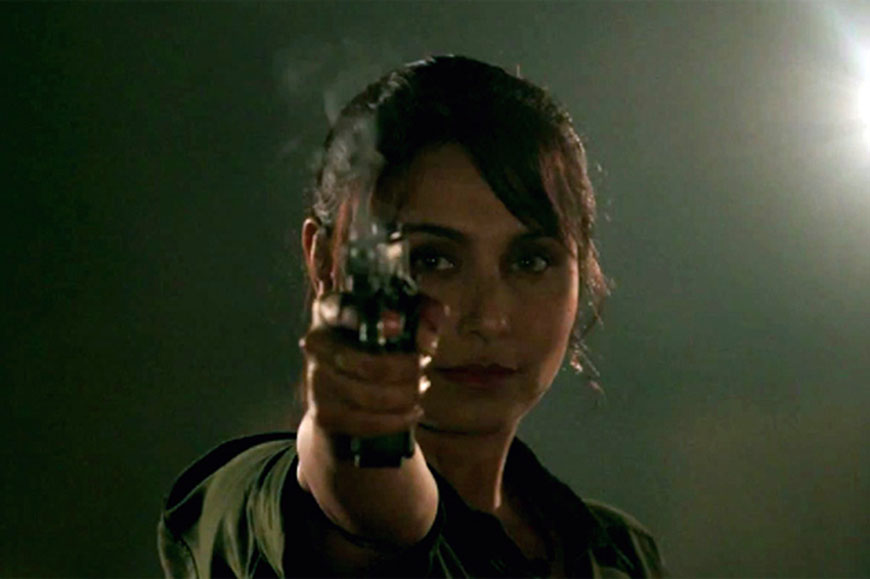‘Mardaani’ has projected itself to be the ‘new crusader on the block’ which talks about the trade of child sex trafficking. Soumabrata Chatterjee explores the role of mass media in propagating awareness regarding sexual violence and the politics of ‘recognition’ which underlines such a project…
‘Mardaani’ released. One of my professors in his/her Facebook wall claimed that the title is deeply problematic because the revolutionary capability of a woman is somehow signified in masculine terms. In a brief monologue near the end of the film, Rani Mukherjee suggests that every woman should search for that element of “mardaani” in herself in order to counter the phallic domination. So, my professor was right. Instead of “mardaani”, the film could have used the title of “janaani” (the word for woman in North Indian languages) but then the latter often represents a “whining, complaining woman” (his/her words) … And that’s not suitable for a film which wishes to project a woman who is virile and full of machismo.
But…. Rani wins, at last. The villain is defeated. The film also mentions that the work is still incomplete so it surely does not portray a liberal, over-arching narrative. There are things to be done; women to act and be acted upon; films to come; life to move on… Shouldn’t a film always end with some hope to play with?
However, these questions have been probed, answered, rubbished and finally forgotten. What is interesting (for lack of a better word) in the film is its portrayal of sexual violence through child trafficking. Throughout the film there is an array of horrifying images of forceful stripping, rape, molestation, and sadism.
So, the film serves as a crusader which takes upon itself the task of appropriately representing the trade of child trafficking in all its barbaric totality. That we live in a world of images is a fact which is well established. The scenes of sexual violence in the film are supposed to awaken our conscience to a certain degree and probably make us sympathetic. But what if it does the opposite? What if, the elaborate sexual perversions shown in the film serve the inherent purpose of stabilising that which it intends to expose and destroy?
First of all, it is not a question of aesthetics here or camera angles or the director’s eye. An interesting anecdote might clear things up a little bit. A quick journey through the history of Bollywood films (mainstream) would probably show us that we have been uncomfortable with the idea of a sexual relation between unmarried couples. The suhagraat (or the first wedding night) is celebrated but that suits the purpose of heteronormativity. However, we have had elaborate scenes of attempted rape. With much trepidation (because I don’t have empirical proof), I proceed to ask: Why is it that our culture is coy in the case of a consensual sexual relation but volatile and abrupt when it comes to rape?
In this world of images, the doctors, journalists, movement activists and cultural scientists often cajole the rape victims to speak out in public, relating their harrowing stories. There is an elaborate theater of ‘confession’ (a word which Foucault absolutely hated!) created by the mass media. Renee Heberle argues that “as the ever-enlarged map of women’s sexual suffering is pieced together, it becomes, in effect, the social insignia of male power.” But how is that possible?
Speaking/ discussing about experiences regarding sexual violence serve the purpose of persuading a society as to its reality of a rape culture. It is like catching a mirror up to society so that it can recognise and modify itself. The victim speaks out and his/her words get proliferated through media for its various ideological uses. Also, the idea of a confession often presupposes the existence of a monolithic listener who has the ability to pierce the subjectivity of the confessor and bring out the truth. He becomes a God-like figure in his omnipotence. The subject of our discussion (i.e. the victim) suddenly becomes the object of scrutiny. It is our innate curiosity about aforementioned experiences that gives birth to such scenes of forceful stripping which could have been hinted at. But subtlety is a lost art. It is our personal desire (to know what is hidden) which inscribes violence on the subjectivities of the women at those moments of rape or forceful stripping. At the precise moment of her vulnerability, the journalistic, sadistic eye seems to investigate just as the mass media intrudes her privacy to propagate an objective vision of a society trying to come to terms with its reality.
Taking a cue from Elaine Scarry’s research on the relationship between pain and power, I seek to argue that these modes of confession through mass media actually nurture those structures of domination which it endeavours to destroy. Scarry explains to us how pain as an emotion is quite personal. The word ‘personal’ here should not be taken in its simplest form. What she means is that unlike anger, hatred or love, pain does not have an object to refer to. Perhaps she means that pain (as an intimate emotion) is related to the ‘being’ of the confessor. By creating a plethora of confession boxes we have transformed the private into the public. However the problem remains that pain cannot be shared. It is not sociable. Infact, Scarry claims that pain is almost antithetical to language itself. Now something which is potentially so disruptive that it decries the rule of logic cannot be sustained within the societal fabric which boasts of reason. But we see confessions, narratives of pain on national television, right? We understand them, right? How does meaning reach out to us, then?
Scarry’s understanding is that these confessions create the illusion of a stabilised patriarchal control and hides its fragmentary status. Rape and other forms of sexual violence have achieved such a pernicious status in our society not only because they harm the individuality of a woman but because they create the myth about destroying it permanently. We have put the perpetrators of such violence in such privileged positions that they dictate not only the present but also the future lives of their victims. Why ‘privileged’, you might ask? Sexual violence destroys the chance of redemption. I am not talking about the atavistic nature of such an act. I am rather pointing out the societal impact that it produces. It creates the illusion of the torture being irreversible. The victim will always remain a victim. It is that moment of violence which dictates the rest of her life. She is caught in the role of the ‘victim’. If we talk about our societal roles being performative, she is bound to act the ‘victim’ all her life. As Renee Heberle says, “what if in emphasising the strategy of piecing together our reality as a rape culture through speakouts and detailed descriptions of experience, we participate in setting up the event of sexual violence as a defining moment of women’s possibilities for being in the world?”
Let us problematise it further. What if, in this drama, this interminable tension between the victim, her confessional impulse and the camera we somehow portray the masculinist domination to be irreversible? What if, we have tried to portray the ‘rape culture’ of our society but have only succeeded as to showing that the phallic pride is almost invincible? What was journalistic and ‘realist’ (implying a derelict society) becomes a sophisticated torture chamber where victims are pulled up, showcased, examined, cried for and then theorised upon. I am doing the same thing. I have to write about such experiences in order to expose the politics of recognition. Why recognition? Because their stories prove to us how barbaric we are in our intentions. The “catharsis of recognition” (Heberle) merely creates a monolithic structure of male domination whose effects are untraceable and irreversible. The word ‘patient’ probably fits better than the apologetic term ‘victim’. There is a deliberate political strategy, which in the name of women awareness campaigns promotes the vision of a patriarchal edifice which is otherwise fraught with internal contradictions.
In this grand narrative of “women V/s men”, we tend to forget that child sex trafficking is not limited to women. Trafficking of young boys is a glaring absence in the film. It is the trope of our society to hunt for victims and create a myth out of them to serve our nationalist fantasies. The country comes together to mourn for the victim. The candle light marches, the Facebook posts, articles in magazines all publicise what is personal. We gloat, theorise and ultimately historicise !!














